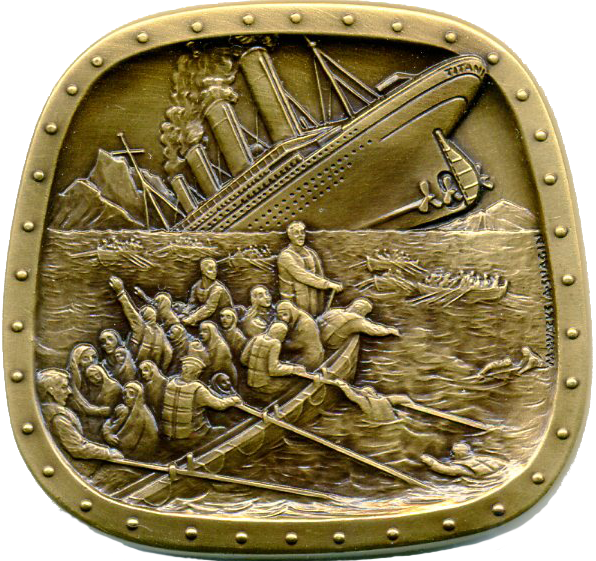 |  |
Isidor & Ida Straus and David Sarnoff medal designed by Alex Shagin from a concept of Mel Wacks.
Struck by Medalcraft Mint in quantities of 450 bronze and 280 pure silver; plus 40 cast in 10kt gold.
Obverse: Portraits of Isidor & Ida Straus, and David Sarnoff, ISIDOR & IDA STRAUSS, David Sarnoff.
Reverse: Titanic sinking and survivors in lifeboat, M. WACKS A. SHAGIN. 49 x 47 mm.
Isidor and Ida Straus
Born in Bavaria in 1845, Isidor Straus came to the United States at the age of 9, residing first in Georgia and then in New York City. Together with his brother Nathan, Isidor started to sell glassware and china in R. H. Macy’s in 1873. By 1896, the enterprise was so successful that the Strauses purchased the entire store, helping to build what is now one of the largest store chains in the world.
Isidor Straus was a trusted advisor to President Grover Cleveland, and he served briefly in Congress. Isidor was also a founder of an endowment fund for the Jewish Theological Seminary.
When the “unsinkable” Titanic sank on its maiden voyage, 1,513 lives were lost. Especially hard-hit were the men in First and Second Class and all Third Class passengers. As the Titanic was sinking, 67-year-old Isidor was told that he would be allowed to depart with the women and children. But he firmly refused any special treatment, saying he would enter a lifeboat only with the other men. He urged his wife Ida to board a lifeboat, but she also declined, reportedly saying, “We have been living together for many years, and where you go, I go.” Mrs. Straus’ loyalty and fidelity to her husband. struck a chord with people around the world,
Rabbis spoke to their congregations about her sacrifice, articles in Yiddish and German-language newspapers extolled her courage, and a popular song featuring the story of Ida Straus, The Titanic’s Disaster, became popular among Jewish-Americans. Over 40,000 people attended the couple’s memorial service.
Following the Titanic disaster, young 21 year-old David Sarnoff remained glued to his wireless earphones in New York for 72 hours straight, and was one of the first to relay the names of the survivors from the Carpathia’s telegraph operator to newsmen and frantic family members.
David Sarnoff
Born in 1891, in a shtetl near Minsk, Sarnoff came to America at the age of 9. His father died when David was only 15, so he left school, and taught himself Morse Code. In the year 1915, David Sarnoff conceived of the idea that radios could “bring music into homes by wireless,” but his memo to his superiors at the Marconi Company was dismissed as a wild scheme.
When Sarnoff joined RCA in 1920, they agreed to develop his concept. Just three years later, Sarnoff wrote, “I believe that television will come to pass in due course,” and at the 1939 New York World’s Fair he proudly showed off the latest electronic marvel. Five years later, President Roosevelt appointed Sarnoff as a Brigadier General, and the Television Broadcasters Association conferred upon him the title “Father of American Television.”